Has anyone kept or currently keeping the Panamius Panamensis (formerly Cryptoheros Panamensis) and able to give me some information on keeping them?
Panamius Panamensis
- Thread starter MarvGT
- Start date
I have kept them twice, for a couple years in the 90s, and again between 2005 and 2010.
Treat them in the same way as any other Amatitlania, although they are a little more shy and less aggressive, I prefer to give them a tank without any other cichlids and only geographically correct dither fish like live bearers as tall mates. They are omnivores so I fed a pellet high in Spirulina, like Algaemax
Both times I kept them they spawned young, at barely 3".
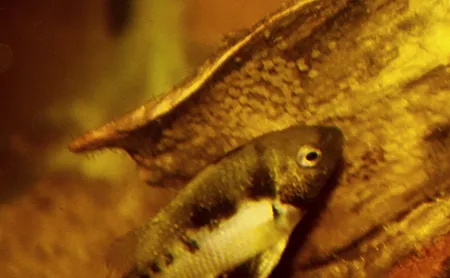
Above a young female with eggs.
Below female with fry
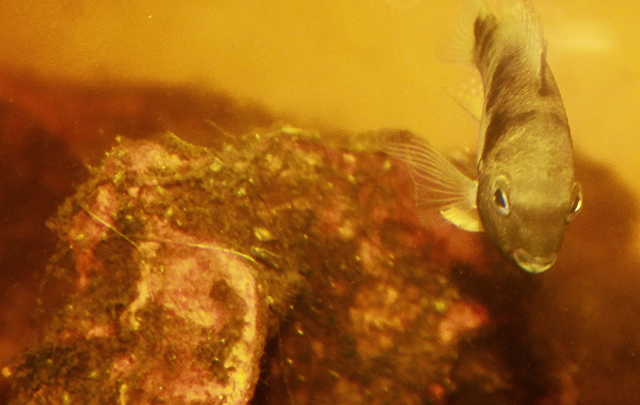
Below young male with fry
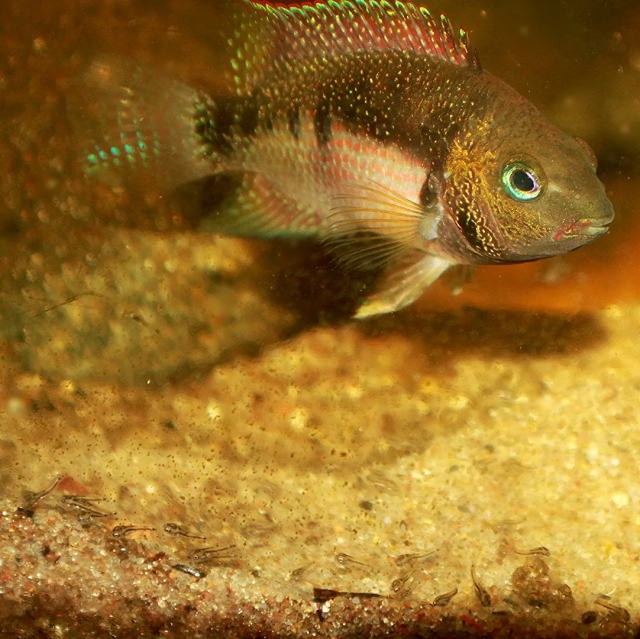
When young I found a tank in the 50-75 gal range was tolerated, moved them up to 6ft tanks later after some growth.
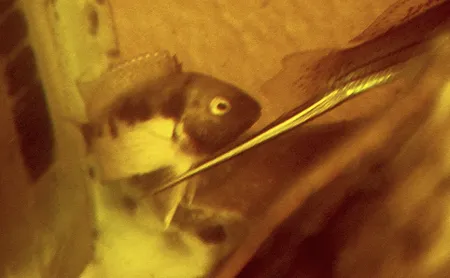
Treat them in the same way as any other Amatitlania, although they are a little more shy and less aggressive, I prefer to give them a tank without any other cichlids and only geographically correct dither fish like live bearers as tall mates. They are omnivores so I fed a pellet high in Spirulina, like Algaemax
Both times I kept them they spawned young, at barely 3".

Above a young female with eggs.
Below female with fry

Below young male with fry

When young I found a tank in the 50-75 gal range was tolerated, moved them up to 6ft tanks later after some growth.

Last edited:
I've had my big male for 5 years now. Got a group of 6 of them in 2016, kept them in a group for a couple years. Had some spawns from the big male and a female. When I sold the extras and had just the pair alone, male killed the female. Now the male is in a 55 gallon solo, and he is an enjoyable "wet pet". Biggest one I've seen, he is pushing 7".
They are pretty aggressive like most CA cichlids tend to be. When I had my group they were in a 5' tank and did alright. I would consider 75g minimum for a group long-term. Mine also developed some HITH when kept in softer water in a planted tank, but do fine in my tapwater which has some hardness to it and higher pH.
They are pretty aggressive like most CA cichlids tend to be. When I had my group they were in a 5' tank and did alright. I would consider 75g minimum for a group long-term. Mine also developed some HITH when kept in softer water in a planted tank, but do fine in my tapwater which has some hardness to it and higher pH.
I’ve had two groups and had a disaster both times.
The first time was a trio that was rehomed to me and they all had hexamita. I treated that, then the smaller female was killed. I kept the male and female in a 75 with some Heros growouts and eventually the male either killed the female or she died; she never really looked great after the hex treatment. I introduced the lone male into my 220g with some Heroina isonycterina and without hesitation they apparently murdered him, which was out of left field.
The second time I got 10 tiny fry and raised them until they were about 2.5 - 3”. They were doing great and the females were starting to show their early spawning colors. I went away for a long weekend and came back to find all ten were dead, floating in the pothos roots in my tank. They were sharing the tank with some Geo growouts and the Geos were absolutely unfazed. There was no ammonia or disease that I could see. To this day I have no idea what went wrong.
Dan Shariffi at Cichlids of the Americas got wild adult stock from Max Cichlids and will hopefully breed them and make F1 available. I don’t plan to try them again until I can get some of those.
If I had a suggestion, it would be to give them a larger tank than you think they’d need, and give them plenty of hiding places and dithers. Keep their stress low, feed them the proper diet, and make sure their water quality stays high to avoid the hexamita issue. I don’t know if it’s just because the ones in the hobby are so inbred or if it’s a feature of the species, but they don’t seem to handle any minuscule amount of stress well.
The first time was a trio that was rehomed to me and they all had hexamita. I treated that, then the smaller female was killed. I kept the male and female in a 75 with some Heros growouts and eventually the male either killed the female or she died; she never really looked great after the hex treatment. I introduced the lone male into my 220g with some Heroina isonycterina and without hesitation they apparently murdered him, which was out of left field.
The second time I got 10 tiny fry and raised them until they were about 2.5 - 3”. They were doing great and the females were starting to show their early spawning colors. I went away for a long weekend and came back to find all ten were dead, floating in the pothos roots in my tank. They were sharing the tank with some Geo growouts and the Geos were absolutely unfazed. There was no ammonia or disease that I could see. To this day I have no idea what went wrong.
Dan Shariffi at Cichlids of the Americas got wild adult stock from Max Cichlids and will hopefully breed them and make F1 available. I don’t plan to try them again until I can get some of those.
If I had a suggestion, it would be to give them a larger tank than you think they’d need, and give them plenty of hiding places and dithers. Keep their stress low, feed them the proper diet, and make sure their water quality stays high to avoid the hexamita issue. I don’t know if it’s just because the ones in the hobby are so inbred or if it’s a feature of the species, but they don’t seem to handle any minuscule amount of stress well.
I had 1 group (3 females 1 male) and lost them to hexamita within 2 weeks of picking them up. They seemed to act like amatitlania, but I didn’t have them long enough to even get them settled in. They are a beautiful cichlid who we don’t see enough of in the hobby. I would love to keep them again
Thanks for the information guys and some worrying stories as well.
So I have 6 on order with my LFS but don’t have much info on them. They’ve been described as small/medium sized and aren’t labeled as wild caught so I am assuming they are tank bred.
I will keep them in an empty 35 gallon 3’ quarantine tank for at least two weeks and from your stories I think I will treat the tank with prazipro from the outset and cross my fingers.
Once they have settled in and provided they aren’t too small I will move them to my 6’ 135 gallon and will share that tank with my vieja bifasciatum. He is a at least 12 inches and although fairly aggressive he has shared that tank with amititlania and Nicaraguensis before and got along fine. He’s so big that even if he did take a dislike to them I highly doubt he’d be able to get anywhere near them especially as I will create a few more hiding places he can’t get into.
The tank is kept at 26°C and PH is usually 7.5 and I will do weekly water changes between 40-50%. I have it on good authority that this should be fine but interested to hear others opinions and advice.
Thanks again.
So I have 6 on order with my LFS but don’t have much info on them. They’ve been described as small/medium sized and aren’t labeled as wild caught so I am assuming they are tank bred.
I will keep them in an empty 35 gallon 3’ quarantine tank for at least two weeks and from your stories I think I will treat the tank with prazipro from the outset and cross my fingers.
Once they have settled in and provided they aren’t too small I will move them to my 6’ 135 gallon and will share that tank with my vieja bifasciatum. He is a at least 12 inches and although fairly aggressive he has shared that tank with amititlania and Nicaraguensis before and got along fine. He’s so big that even if he did take a dislike to them I highly doubt he’d be able to get anywhere near them especially as I will create a few more hiding places he can’t get into.
The tank is kept at 26°C and PH is usually 7.5 and I will do weekly water changes between 40-50%. I have it on good authority that this should be fine but interested to hear others opinions and advice.
Thanks again.
I now live in Panama, close to the area where this species is commonly found (although I don't have any at the moment).
One of the other most commonly found cichlid species found in this area is Andinoacara coerleopuntatus.
Other fish found with them are tetras, gobys and live bearers
Average pH of natural waters here is 8 to 9, (I checked the other day, and even the pH of rain is 8).
Water temps hover in the high 70s to low 80s.
When (If ?) I catch some, I will probably not house them with other cichlids.
One of the other most commonly found cichlid species found in this area is Andinoacara coerleopuntatus.
Other fish found with them are tetras, gobys and live bearers
Average pH of natural waters here is 8 to 9, (I checked the other day, and even the pH of rain is 8).
Water temps hover in the high 70s to low 80s.
When (If ?) I catch some, I will probably not house them with other cichlids.
Thanks for the information Duanes.I now live in Panama, close to the area where this species is commonly found (although I don't have any at the moment).
One of the other most commonly found cichlid species found in this area is Andinoacara coerleopuntatus.
Other fish found with them are tetras, gobys and live bearers
Average pH of natural waters here is 8 to 9, (I checked the other day, and even the pH of rain is 8).
Water temps hover in the high 70s to low 80s.
When (If ?) I catch some, I will probably not house them with other cichlids.
You say you will probably not house the panamensis with other cichlids, is this a personal preference or due to some of the issues Ryan mentioned?
The reason why I am getting the panamensis is because I wanted to add a group of small to medium size cichlid to accompany my solo vieja bifasciaitum. I have kept amititlania nigrofasciata (convict) with him before and it worked really well. This time I wanted to try something a bit different and looked at the other amititlania and cryptoheros species. I considered the Cryptoheros Nanolutea but aside from being very unlikely that I could get hold of them from my area I read they are best kept in species only tank. I then found the panamensis and instantly loved their colors and read that they could make good tank mates with my bifa due to wanting the same sort of diet, water parameters and temperature. I’m sure he won’t mind me saying but I messaged Willem Heijns and asked for his advice. He said the parameters for either species were not too important and the panamensis would easily hold its own against the bifa provided they had enough hiding spaces.
I know you have had a lot of experience in keeping different species of vieja and also the panamensis Duanes so I guess I am just after some reassurance that this is a valid plan short term and long term and the panamensis will not get overly stressed to cause the sort of issues the others mentioned above.
Thanks again
As far as personal preference, I like to keep biotopes of appropriate spaces together. So again, to me, keeping bifasciata from Mexico from thousands of miles away from a Panamanian, would not be my preference.Thanks for the information Duanes.
You say you will probably not house the panamensis with other cichlids, is this a personal preference or due to some of the issues Ryan mentioned?
The reason why I am getting the panamensis is because I wanted to add a group of small to medium size cichlid to accompany my solo vieja bifasciaitum. .
Thanks again
I also do not like to keep cichlids of the same shape, mouth type, and coloration together, they seem to end up competitors.
There are no Vieja found in the Panamense area, except maybe young maculicauda, but even they ultimately seem move to and inhabitant different biotopes.
If your bifasciatta isn't aggressive with Amatitlania, then if you're not concerned with being geographically correct, why not.
As an aside, the A nanoluteus I have kept do not seem to be bold enough to be kept with Vieja.
One Amatitlania (Cryptoheros) species closer geographically might be A cutteri, they are fairly tough, and could withstand a Vieja attitude problem.
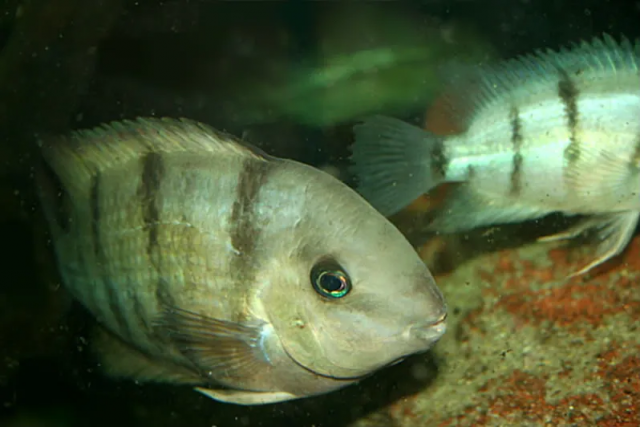
Thanks for the reply Duanes.As far as personal preference, I like to keep biotopes of appropriate spaces together. So again, to me, keeping bifasciata from Mexico from thousands of miles away from a Panamanian, would not be my preference.
I also do not like to keep cichlids of the same shape, mouth type, and coloration together, they seem to end up competitors.
There are no Vieja found in the Panamense area, except maybe young maculicauda, but even they ultimately seem move to and inhabitant different biotopes.
If your bifasciatta isn't aggressive with Amatitlania, then if you're not concerned with being geographically correct, why not.
As an aside, the A nanoluteus I have kept do not seem to be bold enough to be kept with Vieja.
One Amatitlania (Cryptoheros) species closer geographically might be A cutteri, they are fairly tough, and could withstand a Vieja attitude problem.
View attachment 1465583
I appreciate your point there and although I am becoming more aware of the regional/biotope ideology, I cannot pass up the chance to keep these beautiful cichlids. However it is something I will bare in mind going forward when I plan future stocks. My bifa is over 7 years old now and although I hope he has a good few years left in him I will not be replacing him with another large Vieja unless I can upgrade to a far larger tank which leave me with (provided all goes well), a chance to keep the panamensis in a species only tank or with something closer to their region.
Interesting point regarding the nanolutea and is consistent with what I have read about them from other members on here and a wider internet search. Definitely a species I’d like to keep in future, given the opportunity, but one I will wait until I can dedicate a tank to as the only cichlid species.
Thanks again all for the information and advice. I may put a thread up when I manage to get hold of the panamensis to show how I/they get on.
Cheers









